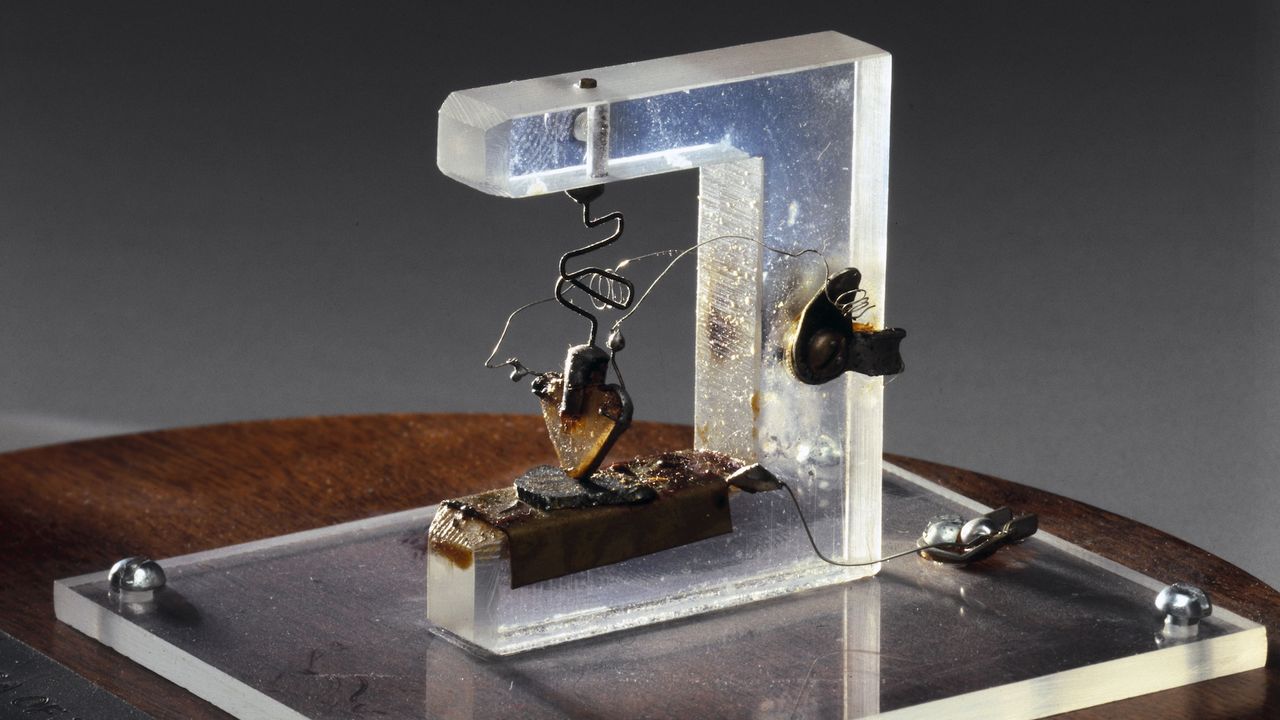0 Reacties
0 aandelen
103 Views

Bedrijvengids
Elevate your Sngine platform to new levels with plugins from YubNub Digital Media!
-
Please log in to like, share and comment!
-
 YUBNUB.NEWSGoogle, NBCUniversal Strike Agreement for Shows on YouTube TVA person walks past a signage of Comcast and NBC Universal in the lobby of the corporate headquarters of Comcast in Philadelphia, Pa., on Nov. 20, 2024. Bastiaan Slabbers/ReutersGoogle and NBCUniversal0 Reacties 0 aandelen 104 Views
YUBNUB.NEWSGoogle, NBCUniversal Strike Agreement for Shows on YouTube TVA person walks past a signage of Comcast and NBC Universal in the lobby of the corporate headquarters of Comcast in Philadelphia, Pa., on Nov. 20, 2024. Bastiaan Slabbers/ReutersGoogle and NBCUniversal0 Reacties 0 aandelen 104 Views -
 WWW.LIVESCIENCE.COMScience history: Invention of the transistor ushers in the computing era Oct. 3, 1950On Oct. 3, 1950, three Bell Labs scientists received a patent for a "three-electrode circuit element" that would usher in the transistor age and the era of modern computing.0 Reacties 0 aandelen 103 Views
WWW.LIVESCIENCE.COMScience history: Invention of the transistor ushers in the computing era Oct. 3, 1950On Oct. 3, 1950, three Bell Labs scientists received a patent for a "three-electrode circuit element" that would usher in the transistor age and the era of modern computing.0 Reacties 0 aandelen 103 Views -
 WWW.THEHISTORYBLOG.COMTreasures found in largest Hellenistic tumulus in RomaniaExtraordinary treasures unearthed from a 3rd century B.C. tumulus in Mangalia, southeastern Romania, were revealed to the public for the first time last month at the National Museum of Romanian History in Bucharest. The finds include jewelry, gold and silver harness fittings, textile appliques and two gold and two silver vessels of delicate and refined craftsmanship. These rare vessels are so remarkable comparable examples have only been found in the royal tombs of Vergina in Macedonia and the tomb of Thracian King Seuthes III in Bulgaria.The tomb was uncovered this summer in an excavation of the tumular necropolis of the ancient city of Callatis. Its semi-cylindrical vaulted ceiling was topped by a large burial mound 40 feet high and 230 feet in diameter, the largest Hellenistic tumulus tomb in the western Black Sea region, so large it could be seen from the sea. It is not just notable for its size, but also for the quality of its architecture. It is an artfully, thoughtfully designed structure evincing a fine sense of proportion. The longest section of stone construction of the tomb excavated this summer is 60 feet long, and there could be more to uncover. So extravagant a tomb had to have belonged to an elite Greek family with connections to Macedonian religious and political power structures.The tomb was looted very soon after its construction, but it was immediately repaired, enlarged and re-consecrated with offerings including a large amount of alcohol. Its contents are very well-preserved, with wood, textile and human remains found in good condition. Among the exceptional artifacts inside the tomb were three gilded bronze funerary wreaths designed to look like ivy and myrtle wreaths complete with gilded ceramic berries. They were mounted on a wooden stand, preserved for thousands of years in the tumulus burial chamber.Archaeologists also discovered glass and bronze ornaments, wood fragments with traces of surviving polychromy, possibly from wooden sarcophagi now lost and elements of carved painted limestone and marble that may have adorned the sarcophagi. The remains of at least two young people were found in the tomb. Osteological analysis found one was aged 16-18, the other 8-11. Some of the artifacts suggest at least one of the deceased was female.Callatis, a city founded by Greeks from Heraclea Pontica and Megara at the beginning of the 4th century B.C., was one of the richest and most influential Greek cities on the Black Sea in the Hellenistic era. Leader of a regional coalition of Greeks, Thracians, and Scythians, at the end of the 4th century BC, the ancient city opposed the Macedonian king Lysimachos, who had inherited the control of Thrace after the death of Alexander the Great.The recently discovered artifacts, with characteristics that will determine their classification in the Treasure category of the national cultural heritage, and their inclusion in the collections of the National Museum of Romanian History, come precisely from this era brilliant, violent and sophisticated. Their in-depth study will allow obtaining new scientific knowledge about the Greco-Thracian-Macedonian world of the 4th-3rd centuries BC.The measure of the ambition of the local Callatian community and its heroic and, somewhat atypically for the Hellenic tradition, aristocratic aspirations, is certainly conveyed by the tumulus necropolis of this ancient city. Stretching for kilometers around the old roads, it amounts to almost a thousand tumuli (funeral mounds), many of them of monumental dimensions (heights of 5 m and more). The vast majority of this impressive landscape, however, disappeared in the last century in which modern Mangalia developed and urbanized. Previous excavations in some of these tumuli have generally been expedient or carried out under conditions of rescue interventions. The recent archaeological research north of Mangalia, presented here, is the first systematic research of a tomb tumulus in Romania and was made possible by the initial use of non-invasive investigation techniques that allowed the precise location of the tomb.The tomb was discovered 9 meters deep below the top of the mound, its arrangement level being at -12 meters. In these difficult conditions, archaeological research was a challenge, pushing all methods of prospecting and documentation to the limit.0 Reacties 0 aandelen 109 Views
WWW.THEHISTORYBLOG.COMTreasures found in largest Hellenistic tumulus in RomaniaExtraordinary treasures unearthed from a 3rd century B.C. tumulus in Mangalia, southeastern Romania, were revealed to the public for the first time last month at the National Museum of Romanian History in Bucharest. The finds include jewelry, gold and silver harness fittings, textile appliques and two gold and two silver vessels of delicate and refined craftsmanship. These rare vessels are so remarkable comparable examples have only been found in the royal tombs of Vergina in Macedonia and the tomb of Thracian King Seuthes III in Bulgaria.The tomb was uncovered this summer in an excavation of the tumular necropolis of the ancient city of Callatis. Its semi-cylindrical vaulted ceiling was topped by a large burial mound 40 feet high and 230 feet in diameter, the largest Hellenistic tumulus tomb in the western Black Sea region, so large it could be seen from the sea. It is not just notable for its size, but also for the quality of its architecture. It is an artfully, thoughtfully designed structure evincing a fine sense of proportion. The longest section of stone construction of the tomb excavated this summer is 60 feet long, and there could be more to uncover. So extravagant a tomb had to have belonged to an elite Greek family with connections to Macedonian religious and political power structures.The tomb was looted very soon after its construction, but it was immediately repaired, enlarged and re-consecrated with offerings including a large amount of alcohol. Its contents are very well-preserved, with wood, textile and human remains found in good condition. Among the exceptional artifacts inside the tomb were three gilded bronze funerary wreaths designed to look like ivy and myrtle wreaths complete with gilded ceramic berries. They were mounted on a wooden stand, preserved for thousands of years in the tumulus burial chamber.Archaeologists also discovered glass and bronze ornaments, wood fragments with traces of surviving polychromy, possibly from wooden sarcophagi now lost and elements of carved painted limestone and marble that may have adorned the sarcophagi. The remains of at least two young people were found in the tomb. Osteological analysis found one was aged 16-18, the other 8-11. Some of the artifacts suggest at least one of the deceased was female.Callatis, a city founded by Greeks from Heraclea Pontica and Megara at the beginning of the 4th century B.C., was one of the richest and most influential Greek cities on the Black Sea in the Hellenistic era. Leader of a regional coalition of Greeks, Thracians, and Scythians, at the end of the 4th century BC, the ancient city opposed the Macedonian king Lysimachos, who had inherited the control of Thrace after the death of Alexander the Great.The recently discovered artifacts, with characteristics that will determine their classification in the Treasure category of the national cultural heritage, and their inclusion in the collections of the National Museum of Romanian History, come precisely from this era brilliant, violent and sophisticated. Their in-depth study will allow obtaining new scientific knowledge about the Greco-Thracian-Macedonian world of the 4th-3rd centuries BC.The measure of the ambition of the local Callatian community and its heroic and, somewhat atypically for the Hellenic tradition, aristocratic aspirations, is certainly conveyed by the tumulus necropolis of this ancient city. Stretching for kilometers around the old roads, it amounts to almost a thousand tumuli (funeral mounds), many of them of monumental dimensions (heights of 5 m and more). The vast majority of this impressive landscape, however, disappeared in the last century in which modern Mangalia developed and urbanized. Previous excavations in some of these tumuli have generally been expedient or carried out under conditions of rescue interventions. The recent archaeological research north of Mangalia, presented here, is the first systematic research of a tomb tumulus in Romania and was made possible by the initial use of non-invasive investigation techniques that allowed the precise location of the tomb.The tomb was discovered 9 meters deep below the top of the mound, its arrangement level being at -12 meters. In these difficult conditions, archaeological research was a challenge, pushing all methods of prospecting and documentation to the limit.0 Reacties 0 aandelen 109 Views -
-
-
-
-
-









